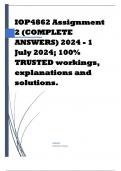IOP4862 Assignment
2 (COMPLETE
ANSWERS) 2024 - 1
July 2024; 100%
TRUSTED workings,
explanations and
solutions.
ADMIN
[COMPANY NAME]
, Case Study (Please note that the case study is not an actual company
situation.) John Sithole is the managing director of manufacturing and
operations of a medium-sized steel construction organisation. John has a
PhD in engineering but has not been directly involved in research and
new product development for 20 years. He runs a “tight ship” when it
comes to operations. The company does not have a turnover problem,
but it was evident to John and other key management personnel that the
hourly people put in only eight hours daily. They are not working at
their full potential and have become “clock watchers”. John is upset with
the situation because, with rising costs, the only way the company can
continue to prosper is to increase the productivity of its hourly people.
John called the human resources manager, Zamile de Wet, and said,
“What is it with our people, anyway? Your wage surveys show that we
pay near the top in this region, our conditions are tremendous, and our
fringe benefits are unbeatable. Yet, these people are still not motivated.
What in the world do they want?” Zamile replied: “I have told you and
the CEO time after time that money, conditions, and benefits are
insufficient. Employees also need other things to motivate them.
Moreover, I have been conducting some random confidential interviews
with some of our hourly people, and they tell me they are very
discouraged because, no matter how hard they work, they get the same
pay and opportunities for advancement as their co-workers who are just
scraping by”. John replied, “Okay, you are the motivation expert. What
do we do about it? We must increase their performance”. QUESTIONS:
a) Identify Maslow’s hierarchy of needs and discuss how it relates to the
case study by explaining the motivational problem in this organisation.
(7) b) Discuss Hertzberg’s two-factor theory of motivation and apply it
to the case study to outline motivational challenges in this organisation.
(8) c) Briefly discuss the equity theory and relate it to the case study. (5)




